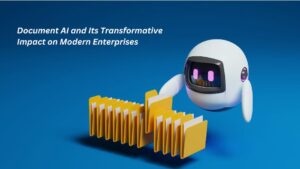Are you struggling with inefficient document processing and costly manual workloads? Document AI could be the game-changer your business needs.

Image Source: Canva
Document AI offers substantial efficiency gains by automating routine tasks, allowing your team to focus on more strategic activities. Moreover, it helps reduce operational costs while ensuring compliance and security in your document management processes.
In this article, let’s explore how Document AI can transform your enterprise, boost productivity, and drive growth.
How Can Document AI Enhance Efficiency in My Business?
Artificial Intelligence (AI) is transforming document processing, leading to notable efficiency gains. By automating routine tasks and minimizing human intervention, businesses can achieve faster and more accurate document handling.
Reducing manual data entry and processing times is a significant advantage of Document AI. Implementing AI solutions streamlines document workflows, enabling your team to focus on strategic tasks. Choosing AI tools that seamlessly integrate with your existing systems and processes is crucial for effective automation.
AI-powered document handling minimizes human errors, ensuring higher data accuracy. To enhance data accuracy, it’s essential to regularly update and train your AI models, employ robust data validation techniques, and continuously monitor system performance. This approach not only improves accuracy but also boosts overall productivity.
Document AI Improves Customer Experience
Document AI plays a pivotal role in improving customer interactions by making them more personalized and responsive. By leveraging AI, businesses can significantly enhance customer satisfaction and loyalty.
Using AI to customize customer communications and services can make your interactions better. Best practices for personalizing customer interactions include analyzing customer data to understand preferences, automating personalized responses, and continuously refining your AI algorithms to better anticipate customer needs.
AI-driven document analysis can speed up the resolution of customer queries. Techniques to improve response times include deploying AI chatbots, automating the sorting and prioritization of customer inquiries, and integrating AI with your customer relationship management (CRM) systems.
Achieving Cost Savings and High ROI with Document AI
Document AI not only improves efficiency but also drives significant cost savings and enhances return on investment (ROI). Understanding and optimizing these financial benefits is crucial for modern enterprises.
Cutting down costs associated with document handling and storage is a significant advantage of Document AI. Effective methods for reducing operational costs include transitioning to digital document management systems, automating repetitive tasks, and reducing the need for physical storage space.
To ensure high ROI from Document AI implementations, it is vital to strategically plan and execute your AI projects. The guidelines for calculating ROI are detailed.
This involves evaluating setup costs. You also estimate time and cost savings. And, you measure the impact on business performance.
| Criteria | Traditional Document Management | Document AI |
| Initial Setup Costs | Moderate | High |
| Ongoing Operational Costs | High | Low |
| Accuracy | Prone to Human Error | High Accuracy |
| Time Efficiency | Time-consuming | Fast Processing |
| Customer Satisfaction | Moderate | High |
| Return on Investment (ROI) | Variable | High |
Ensuring Compliance and Security
Maintaining compliance and security is critical in document management. Document AI offers advanced solutions to ensure regulatory adherence and protect sensitive information.
Automating compliance checks with AI ensures adherence to regulations and reduces the risk of non-compliance. Steps to improve regulatory compliance using AI include using AI-driven monitoring systems.
Also, they involve updating compliance frameworks often and doing periodic audits. Implementing AI to safeguard sensitive information is crucial in today’s digital age.
Recommendations for enhancing document security with AI include using AI to detect and prevent data breaches. Also, they include encrypting sensitive data and continuously monitoring for security threats.
Challenges in Integrating Document AI and How to Overcome Them?
Integrating Document AI into existing systems can present challenges. Addressing technical and workforce-related barriers is essential for a successful implementation.
Implementing Document AI poses common technical challenges. These include system compatibility issues and complex data integration.
Solutions to these challenges involve thorough planning, leveraging expert advice, and employing scalable AI solutions that can adapt to your existing infrastructure. Transitioning to Document AI requires effective management of workforce changes.
The strategies are to smooth the transition and train employees. They include running training programs. They also include encouraging a culture of learning and giving support during the transition.
Steps to Implementing Document AI in Your Business
Implementing Document AI in your business involves a strategic approach that considers both technological and operational aspects. Start by assessing your current document management processes.
Identify areas that would benefit most from AI. Next, select the right AI tools that align with your business needs.
Look for solutions that offer scalability, user-friendly interfaces, and robust support. It’s also essential to engage stakeholders from various departments to ensure a smooth implementation process.
Training your staff is critical for successful AI integration. Develop a full training program. It will cover the functions of the new AI systems.
It will emphasize how they improve daily operations. Regularly update training materials to stay current with technological advancements and changes in business processes.
Measuring the Impact of Document AI
Once Document AI is implemented, it’s crucial to measure its impact to ensure it meets your business goals. Key performance indicators (KPIs) such as processing speed, error rates, customer satisfaction, and cost savings should be monitored regularly.
Collect feedback from employees and customers to identify areas of improvement and make necessary adjustments. Regular audits and reviews help keep Document AI effective.
Ensuring it continues to deliver value. To maximize the benefits of Document AI, maintain a proactive approach by staying informed about new developments and continuously optimizing your AI strategies.
This will help your business remain competitive and responsive to market changes.
Future Trends and Innovations in Document AI
The field of Document AI is rapidly evolving, with new technologies and applications emerging. Staying informed about these trends can help businesses stay ahead of the curve.
Upcoming Document AI advancements include better NLP. They also include smarter machine learning models. And, better integration with other AI is coming. Keeping abreast of these advancements can provide your business with a competitive edge.
Innovative applications of AI extend beyond traditional document processing. Exploring new areas can unlock potential.
These areas include AI-driven decision-making, predictive analytics, and automated content generation. They can also drive business growth.
FAQs
1. What is Document AI?
Document AI involves using artificial intelligence to automate and enhance document processing tasks.
2. How does Document AI improve data accuracy?
AI minimizes human errors and employs advanced data validation techniques for higher accuracy.
3. What are the cost benefits of implementing Document AI?
Document AI reduces operational costs and offers a high return on investment through automation and efficiency gains.





